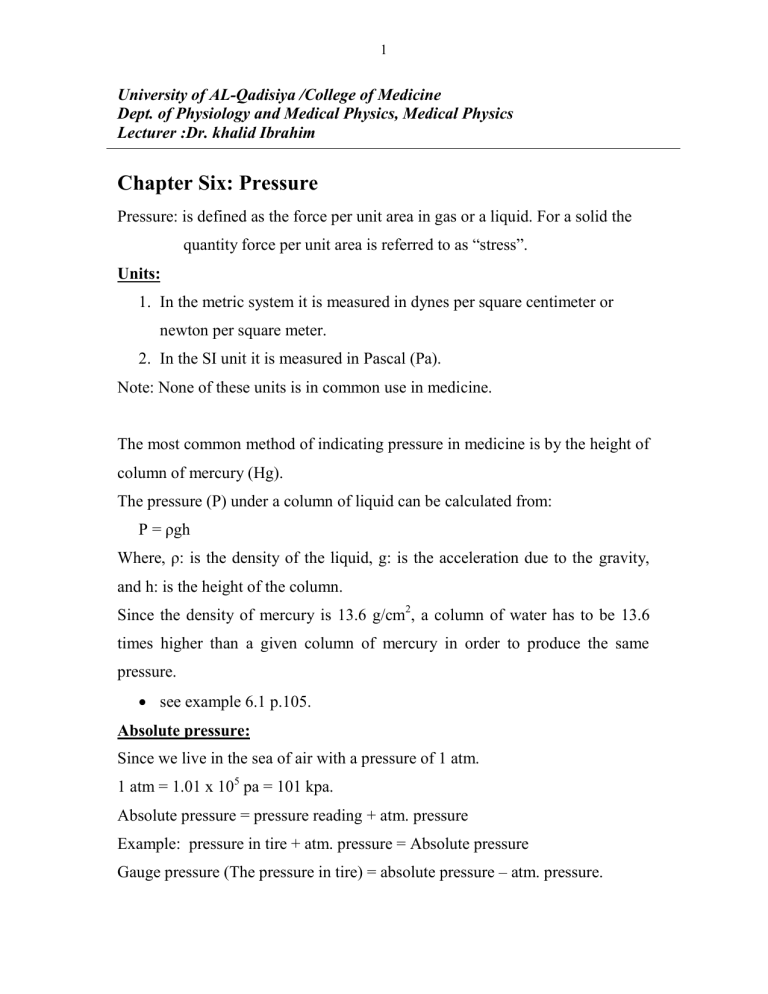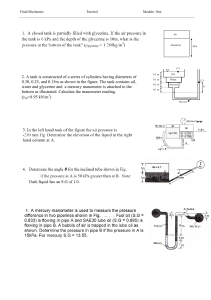
1 University of AL-Qadisiya /College of Medicine Dept. of Physiology and Medical Physics, Medical Physics Lecturer :Dr. khalid Ibrahim Chapter Six: Pressure Pressure: is defined as the force per unit area in gas or a liquid. For a solid the quantity force per unit area is referred to as “stress”. Units: 1. In the metric system it is measured in dynes per square centimeter or newton per square meter. 2. In the SI unit it is measured in Pascal (Pa). Note: None of these units is in common use in medicine. The most common method of indicating pressure in medicine is by the height of column of mercury (Hg). The pressure (P) under a column of liquid can be calculated from: P = ρgh Where, ρ: is the density of the liquid, g: is the acceleration due to the gravity, and h: is the height of the column. Since the density of mercury is 13.6 g/cm2, a column of water has to be 13.6 times higher than a given column of mercury in order to produce the same pressure. see example 6.1 p.105. Absolute pressure: Since we live in the sea of air with a pressure of 1 atm. 1 atm = 1.01 x 105 pa = 101 kpa. Absolute pressure = pressure reading + atm. pressure Example: pressure in tire + atm. pressure = Absolute pressure Gauge pressure (The pressure in tire) = absolute pressure – atm. pressure. 2 Negative pressure: is pressure lower than atm. pressure e.g: during breathing pressure in the lungs must be (–ve) otherwise air will not flow in. Measurement of pressure in the body: The classical method of measuring pressure is to determine the height of a column of liquid that produces a pressure equal to the pressure being measured. An instrument that measures pressure by this method is called a “manometer”. A common type of manometer is a U-shaped tube containing a fluid that is connected to the pressure to be measured. The levels in the arms change until the difference in the levels is equal to the pressure. This type of manometer can measure both positive and negative pressures. The fluid used is usually mercury, but water or other low density fluids can be used when the pressure to be measured is relatively small. 3 The most common clinical instrument used in measuring pressure is the “Sphygmomanometer”, which measures blood pressure. Three types of pressure gauges are used in sphygmomanometer: 1. In a mercury type the pressure is indicated by the height of a column of mercury inside a glass tube. 2. In aneroid type the pressure changes the shape of a sealed flexible container, which causes a needle to move on a dial. 3. Electronic type: The modern type that contains electronic circuit that supported with LCD screen. 1. Pressure in the skull: The brain contains approximately 150 cm3 of cerebrospinal fluid (CSF) in a series of interference openings called ventricles. Cerebrospinal fluid is generated inside the brain and flows through the ventricles into the spinal column and eventually into the circulatory system. 4 One of the ventricles (The aqueduct) is especially narrow. If at birth, this opening is blocked for any reason, the CSF is trapped inside the skull and increases the internal pressure. The increase the pressure causes the skull to enlarge. This serious condition, called (hydrocephalus) or (water-head), it can be often corrected by surgically installing a by-pass drainage system for the CSF. It is not convenient to measure the CSF pressure directly. One rather convenient method is to measure the circumference of the skull just above the ears. Normal values for newborn infants are (32 to 37) cm and a larger value may indicate hydrocephalus. 2. Eye pressure: The clear fluid in the eyeball, that transmit the light to the retina are under pressure and maintain the eyeball in a fixed size and shape, the pressure in the normal eyes ranges from 12 to 23 mmHg. The eye continuously produces aqueous humor and a drain system allows the surplus to escape. If a partial blockage of this drain system occurs, the pressure increases and the increased pressure can restrict the blood supply to the retina and thus affect the vision. This condition called “glaucoma”, produces tunnel vision in moderate cases and blindness in sever cases. 3. Pressure in the digestive system: This pressure is greater than atmospheric pressure in most of the gastrointestinal “GI” system except the esophagus; the pressure is coupled to the pressure between the lung and the chest wall. A: The increased pressure inside the GI system is due to: 5 1. Accumulation of food increase the pressure inside stomach layers, the volume is directly proportional with the cube of the radius (R 3) while the tension (stretching force) is proportional to (R): Vα R3 TαR 2. Swallowing the air during eating food. Air trapped in the stomach causes burping and belching. 3. The gas generation due to the bacterial action increases the pressure. B: There are external factors increases the pressure inside the stomach and these factors are: 1. belts 2. Girdles 3. flying 4. swimming. 4. The pressure in the skeleton: The skeletal system joints are the best bearing that any man can make. The lubrication of it is due to synovial fluid. The large area of the joints, the shape of the bones, and the lubrication by synovial fluid is naturally designed to reduce the pressure on the joints. The finger bones are flat rather than cylinder on the gripping side and the force is spread over a large surface area, this reduces the pressure in the tissues over the bones. 5. Pressure in the urinary bladder: It is due to internal and external factors. The internal factors are due to accumulation of urine inside the bladder. For adults, the typical max. volume before the voiding is 500 ml. At pressure equal to ~ (30 cmH2O). The resulting sizable muscular contraction in the bladder wall produces a momentary pressure up to 150 cmH2O. See the figure followed: 6 The pressure in the bladder can be measured by: 1. Passing a catheter with a pressure sensor into the bladder through the urinary passage. 2. Means of needle inserted through the wall of the abdomen directly into the bladder. This technique gives: Information on the function of the exit valves (sphincters) that cannot be obtained with the catheter technique. The bladder pressure increase due to the external factors like coughing, straining, and sitting up. During pregnancy, the weigh of the fetus over the bladder increase the bladder pressure and cause frequent urination. A stressful situation may also produce a pressure increase; studying for exams often results in many trips to the toilet due to “nerves”. 7 Hyperbaric Oxygen Therapy (HOT): That means use of oxygen for treatment. And as we show in the following: 1. For gas gangrene patients: The bacillus that causes gas gangrene can not survive in the presence of oxygen, almost all gas gangrene patients treated with HOT are cured without the need for amputation. 2. For Co poisoning: In carbon monoxide poisoning, the RBCs can not carry oxygen to the tissues because the CO fastens to Hb at the places normally used for oxygen. With (HOT), the partial pressure of O2 can be increased by a factor of 15, permitting enough O2 to be dissolved to fill the body’s needs. Many victims of Co poisoning are saved with this technique. 3. For treating cancer: HOT has been used in conjunction with radiation in the treatment of cancer.




